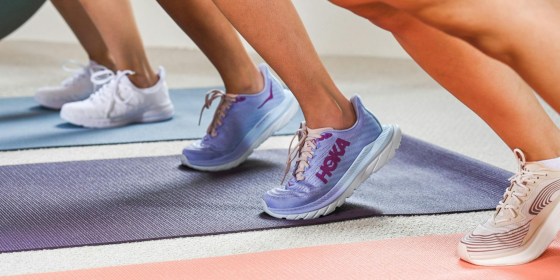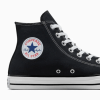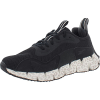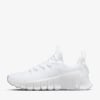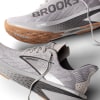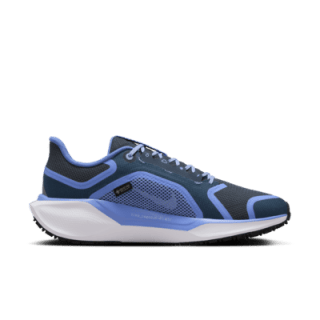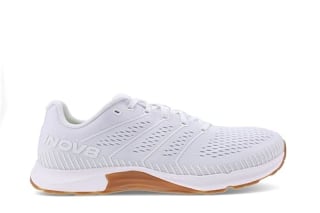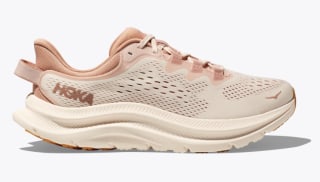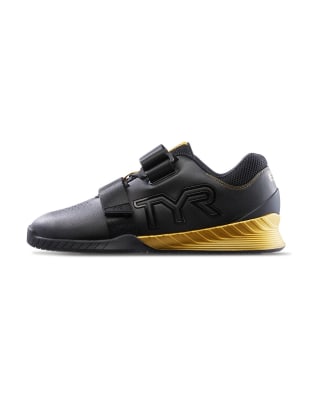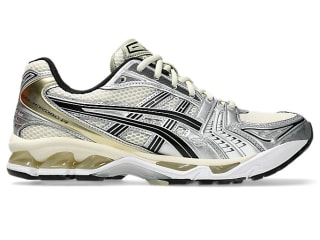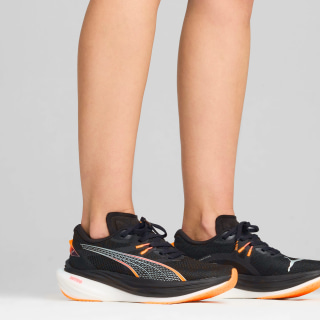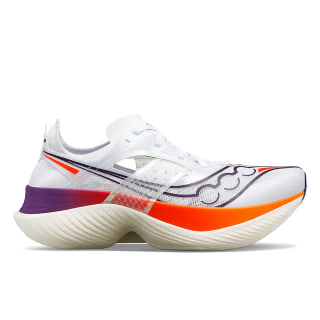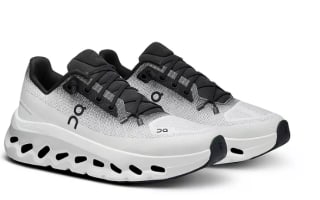Working out requires a specific shoe, like any other activity in your everyday life. Whether you're hiking a mountain, playing pickleball or running a trail, the proper footwear can make or break your workout routine, especially if you're training for a specific sport.
One shoe is not fit for all sorts of workout activities. “You don’t want to use your everyday walking shoe to run and vice versa,” says fitness trainer and runner Ashley Paulson. And take it from a runner (myself) who has attempted to run with the same shoes on race day. They start to deteriorate after a certain number of miles and don't perform as well.
If you want to amp up your workout routine, you should consider a new pair of kicks. "The activity really dictates the shoe requirement," says podiatrist Dr. Joel Peterson. Plus, a new pair of shoes can elevate your fitness goals. Paulson advocates for having a pair of training shoes and a new pair for race days, but everyone's need varies depending on their activity level — and budget!
I talked to runners, fitness trainers and podiatrists to help you with your footwear decisions. Plus, I asked the experts to share their top recommendations and favorite pairs.
Type of workout shoes
According to Paulson, shoes for weight lifting have a harder sole and more of an elevated heel lift to help with squatting, as opposed to running shoes which require more support due to the repetitive motion of each stride.
Generally, workout shoes fall into a few categories: running, training and cross-training. However, there are sport-specific sneaker categories, as well. Here are the main three:
- Running shoes "extend into a few additional categories based on distance, surface and support," says Wood.
- Training shoes "are generally flat and provide stable support for weightlifting," says Wood. Coach and trainer for Tonal Tanysha Renee says flat shoes can be beneficial for ground reaction force.
- Cross-training shoes "are adaptable and allow the flexibility to transition from strength training to dynamic, cardio-based movement, which makes them my go-to shoe when I’m working out on Tonal," adds Wood.
With a myriad of options in the market, experts say to look for not only the type of workout you'll engage in but also your foot type.
"I have flat feet so shoes like Brooks fit best for me for my cross-training workouts and boxing shoes for my boxing training. Someone who has a higher arch may look for shoes like Asics, which is another great cross-training brand," says fitness expert Rodney Carter.
Best workout shoes for women, recommended by experts
Classic Americana: Converse Chuck Taylor All-Star High Tops
- Sturdy construction
- Comfortable
- No arch support
Sizes: 5-18 | Colors: 23 | Features: OrthoLite cushioning | Best for: Weightlifting
"Many gym rats swear by these. There is virtually no heel cushion and the sole is wide and flat so you get good ground contact. They are also very affordable so they are a good starting point for someone getting into weight training," says Peterson.
This pair comes in multiple colors and is a great option if you will use weights, without running.
Training day: Nike Pegasus 41
- Plush cushioning
- Great for cardio classes
- Heel area feels a bit hard
Sizes: 5-12 | Colors: 22 | Features: Full-length foam midsole | Best for: Cross-training
Athlete Anthony Crouchelli says the Puma Deviate is great for runners in the cross-training space, has great cushioning and is extremely light!
The Deviate is offered in waterproof GORE-TEX upper and reflective details to help you stay dry on wet roads. But if you want more color options, you can choose the original version. These shoes are flexible and ideal for casual runs.
Solid trainer: Nike Free Metcon 6
- Very comfortable
- Feels lightweight
- Not ideal for high arches
Sizes: 5-15 | Colors: 18 | Features: Grippy traction, the brand's laser-siped foam in the forefoot and flexible midsole | Best for: Cross-training
According to personal trainer Kendall Wood, this shoe is great for hybrid workouts. "It carries me from one modality to the next with continuous support. Wearing these shoes while on Tonal, I can transition straight from a 15-minute strength quick fit into one of my favorite boxing cardio classes, or focus on French contrast supersets combining a strength exercise with a plyometric exercise," says Wood.
The shoes offer a lightweight feel with a flexible midsole and support throughout to keep you from one workout to the next. Social media producer Anita Chomenko owns this pair and says she "was looking for a new pair of workout sneakers, something lower to the ground and without crazy height so they would be good for weightlifting."
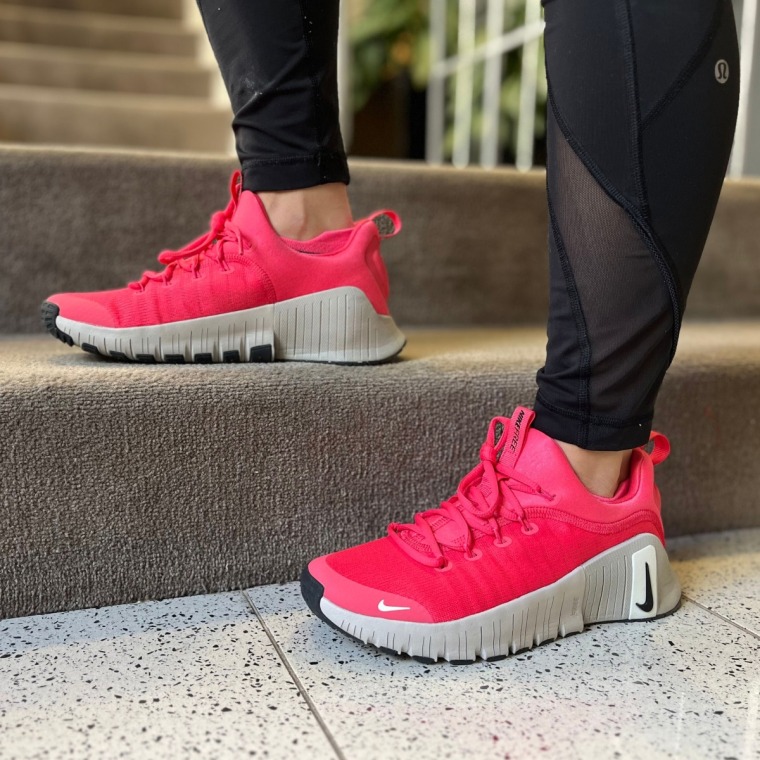
For the gym: INOV8 F-Fly
- Roomy toe box
- Alternative to barefoot shoes
- Runs small
Sizes: 5.5-11 | Colors: 5 | Features: Round toe shape | Best for: Cross-training
If you're looking for a pair that holds up during your circuit training, the F-Fly will give you the support you need. Plus, they have a roomy interior. "These have moderate cushion so you can do some decent running on the treadmill but are supportive enough to manage the majority of resistance training exercises as well," says Peterson.
Most recommended: Brooks Hyperion 2
- Ideal for running
- Lightweight construction
- Not ideal for high-arched foot
Sizes: 5-12 | Colors: 7 | Features: Nitrogen-infused cushioning and breathable mesh construction | Best for: Running
Carter recommends this sneaker for running for "which is arguably one of the best running shoes on the market." He continues that they're "super lightweight and even more comfortable it really does feel like running on clouds." While the Brooks Ghost won best for overall running shoe for Shop TODAY Sneaker Awards, the Hyperion 9 also delivers versatile performance.
It's a cushioned and lightweight shoe that will help you log miles on your watch with ease. "I love these as a good all-around shoe, mainly for running but they work well for me on speed work, short distances, long distances, and I can use them every once in a while for a cross train in a HIIT class," says DeSena.
Just like Carter and DeSena, I [Espinal] love my Brooks shoes. They are very supportive and get me through my runs without any blisters or pain. I've worn my pair for over a year now, and it has been the best gift I've received.
Reliable pair: Hoka Kawana 2
- Provides foot, ankle support
- More stylish than other brands
- Different than previous model
- Not meant for wider feet
Sizes: 5-12 | Colors: 7 | Features: Internal bootie, speckled regrind midsole and single-layer mesh upper | Best for: Running
According to Carter, this shoe from Hoka is "super lightweight and really comfortable; it really does feel like running on clouds." He continues, "However, some really good and affordable options as well are New Balance, Skechers and Under Armour." This design comes in fun colors and will give a pop of brightness to your athleisure sets.
Amanda Fama, a commerce editor at Shop TODAY, enjoys running in her Hoka sneakers — and she wears the Hoka Arahi design, which are ideal for walking and "everyday running," per the brand. Fama says, "I’ve never owned a pair of Hoka sneakers before, and I can honestly say they live up to the hype." She calls them "sturdy and supportive."
Lift with ease: TYR Women's Limited Edition Squat University L-1 Lifter
- Wide toe box
- Great for lifters
- Can run small
Sizes: 5-12 | Colors: 7 | Features: Internal bootie, speckled regrind midsole and single-layer mesh upper | Best for: Weightlifting
Tonal coach Tanysha Renee recommends this training shoe for those who need a wider toe box. The pair is designed with a roomier interior and offers a non-constrained fit. If your workout includes a lot of lifting, this shoe can improve squat depths and torso movements.
"The right weightlifting shoe can not only support you but also improve your posture and form while lifting," adds Renee.
Retro first: Asics Gel-Kayano 14
- Retro aesthetic
- Ideal for wide feet
- Pricier option
Sizes: 5-15.5 | Colors: 3 | Features: GEL technology underfoot | Best for: Running
Carter says, "These shoes like Brooks are great for folks with flat feet and/or may need arch support; additionally one of the most fashion-forward fitness shoes you can buy." While these are on the pricier side, they offer a roomy interior for people with wide feet.
For the road: Puma Deviate Nitro 3
- Breathable
- Ideal for running
- Higher price point
Sizes: 5.5-11 | Colors: 4 | Features: Carbon fibre plate, nitrogen-infused foam | Best for: Running
Opt for this shoe if you're into running and looking to improve your speed. Crouchelli says these shoes are "Breathable with excellent traction, and really held up nicely in a variety of high-level movements." Whether you're a fast or slow runner, this design is engineered to keep you strong during a race. You can also get the previous Deviate version for a cheaper price on Amazon.
Run faster: Saucony Endorphin Elite
- Carbon-plated
- Breathable upper
- Higher price-point
Sizes: 5-12 | Colors: 4 | Features: Carbon fibre plate, nitrogen-infused foam | Best for: Running
"My favorite carbon-plated racing shoe! Fits like a glove, and I feel so fast in these. They gave me my Chicago Marathon PR (personal record)," says DeSena. While these are more costly than other sneakers, they are designed especially for race day as they feature carbon fiber in the midsole. Essentially, they will help you spring forward better while running.
Best workout shoes for women, recommended by editors
Editor-approved: Reebok Zig Dynamica Adventure Sneaker
- Offer mild cushion
- Relatively affordable
- Narrow toe box
- Not ideal for treadmill
Sizes: 5-11 | Colors: 30 | Features: ZigTech outsole | Best for: Cross-training
"When I first started at the gym, I wore these shoes for everything and they got me through every workout. They aren’t as bouncy as running shoes so I could get away with using them on leg days and normal workout days. I wore them for two years before I started switching up my shoes, but they got me through everything," says editorial operations manager Jillian Ortiz.
Walk on clouds: On Cloudfit
- Very comfortable
- Super flexible
- Toe box not as wide
Sizes: 5-11 | Colors: 6 | Features: CloudTec Phase midsole | Best for: Walking and casual runs
"These pull-on sneakers are my go-to pair for long daily walks because they’re lightweight and cushioned. The slight tilt makes even my 20,000 steps feel effortless. They’ve held up in hot, wet and cold temperatures — somehow never feeling too snug even when I opt for thicker, warmer socks," says TODAY health reporter Aryelle Siclait.
Crouchelli also recommends these because of their breathable material and strong traction to connect to the floor.
Features to look for in workout shoes
The first thing you should do before considering a new pair of workout shoes is to get a gait analysis, a method to identify how you walk and any movement patterns. “I have a slight pronation and need a little correction for that. If you don’t have access to a running gait analysis, have a friend record you to analyze your stride and then go to a running store to determine which shoe will help you get to that neutral stride,” says Paulson.
Second, you want to consider the type of workout you’ll be doing. While there are shoes for running and weightlifting, there are other more specific sports categories such as pickleball, tennis, soccer, etc.”
“Finally, getting your feet scanned and having a professional outfitter assess your foot size and shape and overall movement patterns along with talking through your exercise goals is important to finding the right fitting shoe,” says director of brand marketing Ashley Arnold.
How we chose
Numerous experts were interviewed for this topic, including trainers, podiatrists and runners, to determine the best quality footwear for working out. Finally, they provided the best shoes in different categories and gave feedback based on their expertise.
Meet the experts
- Ashley Paulson is a pro runner and fitness trainer for iFit, an interactive fitness and workout app.
- Ashley Arnold is the director of brand marketing at Flat Feet and a former winner of the Leadville 100.
- Dr. Joel Peterson is an orthopedic and sports medicine surgeon at the Badia Hand to Shoulder Center in Miami, Florida and Co-Founder of the Miami Shoulder Institute.
- Mark Lay is a certified trainer, coach and athlete based in Miami Beach, Florida.
- Rodney Carter Jr. is a fitness expert, competitive boxer, and co-owner of Boxing Express.
- Anthony Crouchelli is an athlete and founder of More Than Miles, an athletic club offering sports merchandise.
- Nicole DeSena is a running coach and founder of the run club, On the Run.
- Tanysha Renee is a NYC-based coach and trainer for Tonal.
- Kendall Wood is a certified personal trainer and coach for Tonal.
